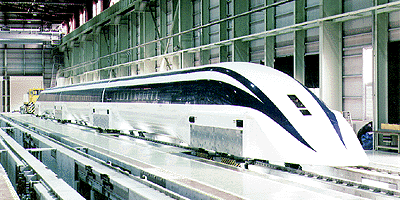
Applications of
Superconductivity/Projected Benefits
With all these unique
properties of superconductors, what can you possibly work with
and what is the motivation for using superconductors?
Applications of superconductors include:
· Transmission Lines
Energy efficiency in
transmission lines is a major issue in power distribution.
There are many sources for energy loss in power distribution,
including in the generators, transmission, and at the
distribution grids. One area of optimization that would
greatly improve the energy efficiency in power distribution is
in the resistive property of transmission lines. In
transmission lines, there can be a 10% to 15% loss of energy
through electrical resistance. By making use of
superconducting materials, this energy loss can be reduced to
nearly 0%! The main setback of this utility is achieving the
rather low temperature. In the case of transmission lines,
liquid helium/liquid nitrogen cooling is required. Prototypes
have been built that work across relatively small distances
(one such prototype is shown below); more research is needed
for worldwide implementation. However, the South Korean
company LS Cable is attempting to establish a power grid
making use of ceramic superconducting wiring, which is
provided by the United States firm American Superconductor.
Another reason the wiring has not been used is because the
ceramic wires are very brittle, making it difficult to bend or
contort the material. This is not ideal.

· Superconducting Motors
For many typical motors,
the efficiency of the electrical to mechanical energy
conversion is fairly efficient. Using superconducting motors
would not improve this efficiency. However, using
superconducting motors would reduce the weight of a motor with
the same output to about 1/10 of its original weight. In
modern times, there is a higher demand for transportation and
power needs. Optimizing the power output to weight ratio would
greatly improve these systems, especially in transportation.
No prototypes have been built of this yet, but a model of how
it would be put together is shown below. Notice how the
inductive coils are replaced by copper stator coils and the
core shaft is surrounded by superconducting rotor cells, which
are actuated by the copper stator coils. Using a motor such as
this would not run into the same problems that using
superconducting wiring would; the brittleness of the material
is not a concern, since the material should not technically be
moving much.

Source:
http://spectrum.ieee.org/energy/renewables/winner-superconductors-on-the-high-seas
· Superconducting Magnetically
Levitated Trains
Magnetically levitated
trains are already in commercial use in many places throughout
the world. However, superconducting materials in the train
have not been in mainstream use. The Japanese Maglev Train
MLX01 (shown below) is a prototype that set a world record
speed of 321 mi/hr in 1979. This train operates by inducing a
current in the rails below the train. The superconductive
magnets, by the Meissner Effect, creates a repulsion of the
current in the rails, which causes the train to levitate. The
alternative method for magnetically levitated trains is using
a set of electromagnets and having the train attached with
magnets. The problems that using this system has and what
using superconductors solved include inefficient use of
electrical energy (most of it is lost through heat in the
electromagnetic coils), having a physical size much larger
than the superconducting system, and having a higher friction
in the magnetic interaction than the superconductors.

Source:
http://www.lanl.gov/orgs/mpa/stc/train.shtml
--------------------------------------------------------------------------------------------
Previous
- Home
- Next